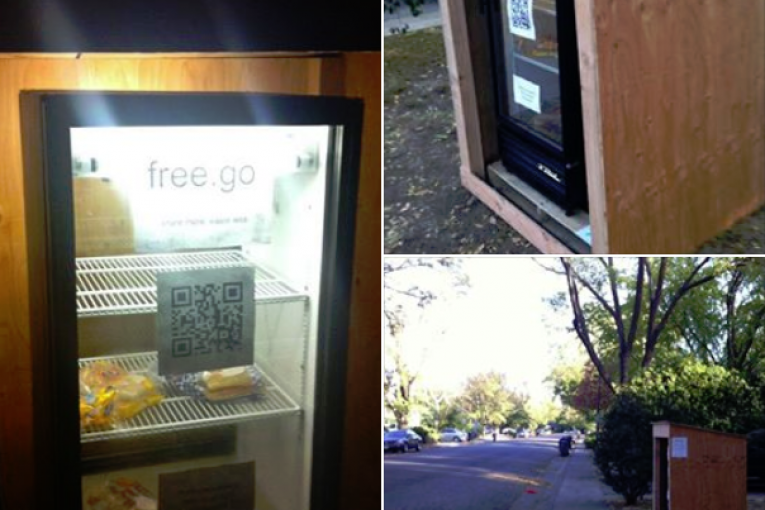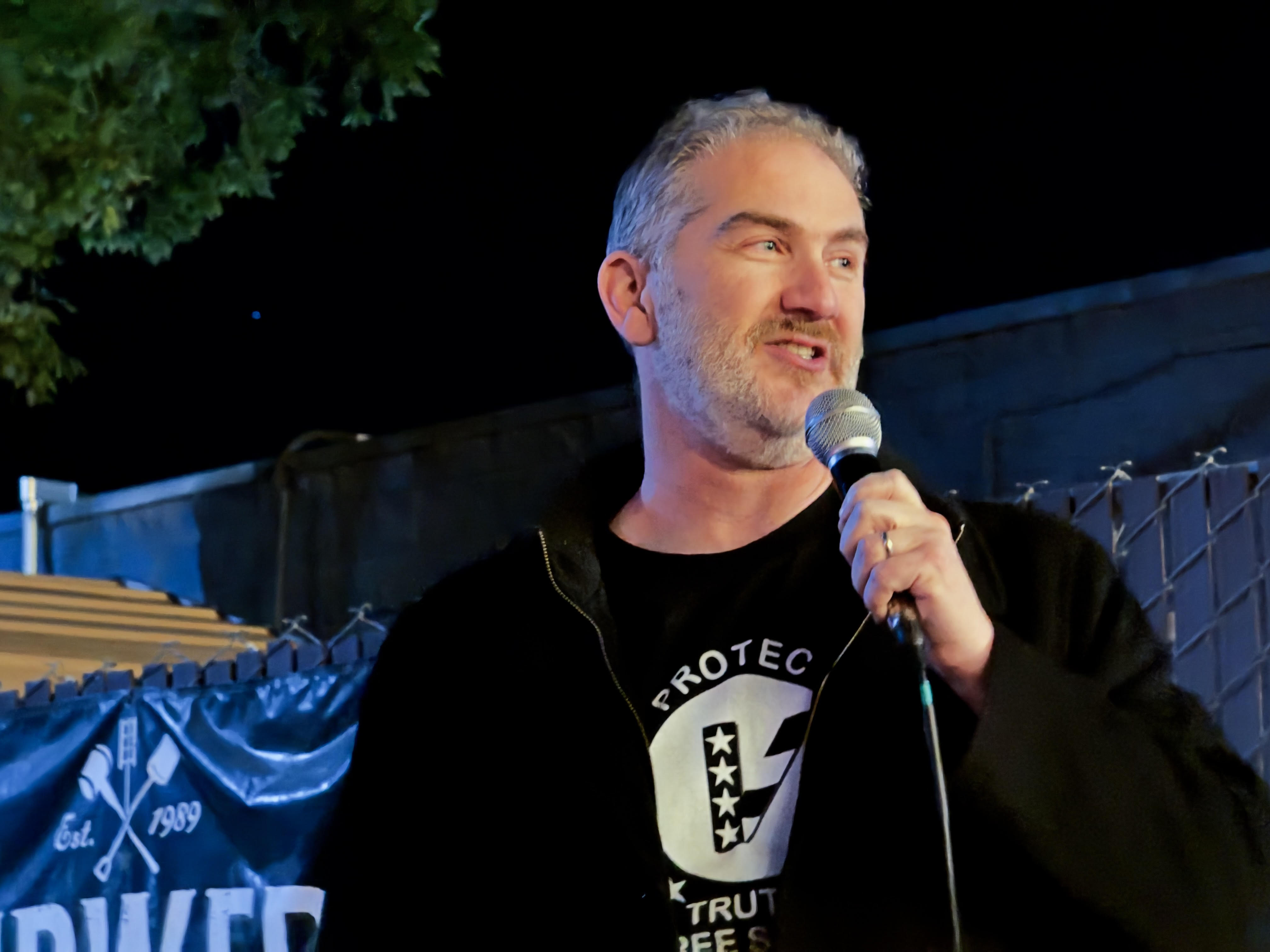

Two weeks ago, a Vanguard reader, Ernst Bertone, wrote an article for the Vanguard that we decided to post. Little did we realize the article on food sharing in Davis would stir up so much controversy, or that the experiment would generate the UC Davis students’ subsequent battle with the health department.
While the idea of food sharing was a controversial for one for our readers, new research indicates that the production of food that we waste in the U.S. generates more greenhouse gases than many entire nations do on an annual basis.
As Mr. Bertone wrote, “In the past few weeks we performed a food sharing experiment in our neighborhood, installing a public refrigerator in our front yard (at 812 Douglass Avenue in Davis, CA). Over 29 days of operation, 122 food items were exchanged, an average of about 4 items per day! In the last days of operation we also had 3 books being shared, which led us to the creation of a space dedicated to book-exchange.”
He adds, “The name of this project is free.go. Our goal is to reduce food waste and build a stronger community through food sharing; we receive no profits, or personal benefits (except for some tasty items that show up in the fridge and need to be consumed fast…). This is an idea starting in Davis, but we recently heard that similar projects are happening in other countries… you might say: convergent evolution!”
A recent article by National Geographic finds, “The energy that goes into the production, harvest, transportation, and packaging of wasted food produces more than 3.3 billion metric tons of carbon dioxide.”
Overall, “More than a third of all of the food that’s produced on our planet never reaches a table. It’s either spoiled in transit or thrown out by consumers in wealthier countries, who typically buy too much and toss the excess. This works out to roughly 1.3 billion tons of food, worth nearly $1 trillion at retail prices.”
They note, “Aside from the social, economic, and moral implications of that waste—in a world where an estimated 805 million people go to bed hungry each night—the environmental cost of producing all that food, for nothing, is staggering.”
“The water wastage alone would be the equivalent of the entire annual flow of the Volga—Europe’s largest river—according to a UN report. The energy that goes into the production, harvesting, transporting, and packaging of that wasted food, meanwhile, generates more than 3.3 billion metric tons of carbon dioxide. If food waste were a country, it would be the world’s third largest emitter of greenhouse gases, behind the U.S. and China,” they add.
The National Geographic cites John Mandyck, the chief sustainability officer of United Technologies, a U.S.-based engineering and refrigerated transport firm who believes “that food waste can be mitigated by improving the ‘cold chain,’ which comprises refrigerated transport and storage facilities.”
Part of the problem, according to Mr. Mandyck, is that “[w]e tend to take our food for granted in the developed world. Since food is so plentiful, we aren’t aware of the tremendous amount that’s wasted and the impact that has on world hunger, political stability, the environment, and climate change. Yet when it comes to looking for ways to curb greenhouse gas emissions, food wastage is a relatively easy fix—the low-hanging fruit, so to speak—and it is literally rotting on our tables. It doesn’t require any new technology, just more efficient use of what we already have.”
There are two forms of food waste – the first is that we buy too much and therefore throw it away. This is where the food sharing idea might have some traction. However, Mr. Mandyck says that two-thirds of the waste happens at the production and district level. For instance, he notes that “a lot of food rots in fields, or is lost as a result of poor transportation networks, or spoils in markets that lack proper preservation techniques. We can make a big difference by transporting and storing our food under proper temperature conditions to extend food supplies.”
“The dividends of avoiding food waste can be historic,” he continues. “We produce enough food to feed everyone on our planet today and the 2.5 billion more people to come in the next 35 years. We have to waste less to feed more.”
Farming already uses 38 percent of all available land compared just two percent for the cities. It also uses 70 percent of available fresh water.
Mr. Mandyck argues, “We can’t keep growing more food, and continuing to waste as much, to feed more people. The environmental dividends are no less significant: lower climate emissions from a major source and more water efficiency to combat growing water scarcity.”
At the consumer level, he suggests, “We can all take small steps that will accumulate to make a meaningful difference. Let’s buy just the food we need so we throw away less. Let’s accept that produce can be top quality and delicious even if it has a slight imperfection in appearance. Let’s bring meals home that we don’t finish in restaurants. Small changes will yield big results.”
But food sharing could play a big role in that, especially if we are able to efficiently take the food that we are not going to eat and would otherwise throw away or spoil, and give it to those who would consume it.
However, as Mr. Bertone has experienced, such an idea has drawn the wrath of the Yolo County Health Department.
As CBS News reported, “The neighbors liked it and even used it. But someone complained, prompting the health department to shut down the sharing fridge. The rationale? The open refrigerator doesn’t assure safe and pure food, and it can lead to people getting sick.”
“The law just hasn’t thought of something like this before, I think. It’s a new idea,” said Eric Yen.
“For now, it’s a new idea that’s against the law, leaving the fridge off the lawn and out of order,” the report concluded.
Are there ways to make this safe and legal? Because, while it is true that two-thirds of the wasted food is wasted before it even gets to one’s refrigerator, it is also true that nearly half a billion tons of food get wasted after people purchase it, and that could have a huge impact not only our ability to feed the world in the future, but also on our ability to mitigate climate change.
—David M. Greenwald reporting

One part of the puzzle, and certainly a low-hanging fruit, what happens to the “waste” after it reaches the end consumer. Clearly there is a huge need to make the entire system more efficient. But when crops rot on the land, it at least returns to the soil. When produce rots at home, the majority of it is trucked off to the landfill, never to benefit anybody again. While I love the sharing idea, the truly low-hanging fruit is to compost what goes bad at home. And we can’t seem to even manage that on a large scale.
Every day we delay the rollout of containers that will allow food scrap pickup, is another day of shooting ourselves in the foot.
The production end needs to be cleaned up, but certainly so does the consumer end. We throw away perfectly good food in the trash today. And that amazes me on many levels as we try to solve the land problem, the water problem, the GHG problem, the landfill problem, the traffic problem, the hunger problem…
an interesting thought at the very least – how much would composting mitigate ghg and other losses.
DP wrote:
> how much would composting mitigate ghg and other loses.
I was always told that composting “produced” green house gasses.
A Google search found the link below:
http://sustainablog.org/2009/07/an-inconvenient-truth-about-composting/
People compost, they don’t need to store a large, ugly, city-owned plastic container in their tiny yards for this. In fact, needing space to store this city-owned container would likely displace a composting container and lead to LESS composting.
I agree Frankly, people do compost. However, composting is rarely done on the top of concrete surfaces. It is almost always either (A) done on top of an earth surface so that worms and bacteria can freely move between the compost area and the native soil, or (B) in much rarer cases done in large plastic containers that can compost both garden greens and kitchen compostables. As a result the green “city-owned plastic container” is highly unlikely to displace composing done by the (A) method, and may in rare cases displace a (B) method composting container; however, in my opinion, anyone who has taken the steps to be a (B) method composter will more than likely be a strong proponent of green containers as well.
P.S. The new metal/glass/paper recycling cart/container being provided by Davis waste Removal has a significantly smaller footprint than the blue and black containers most of us currently have. I suspect that the combined footprint of one of the new blue/black cart/containers and a 65-gallon garbage cart/container is less square inches than one 95-gallon garbage cart/container … and even less if one goes down to a 35-gallon garbage cart/container. For our family of 2 people, we rarely fill our 95-gallon garbage cart/container more than 10% full, so for us down-sizing to a 35-gallon cart/container makes practical sense as a space saving step.
P.P.S. I don’t think any of the plastic carts/containers are “city-owned.”
darellid: “But when crops rot on the land, it at least returns to the soil. When produce rots at home, the majority of it is trucked off to the landfill, never to benefit anybody again. While I love the sharing idea, the truly low-hanging fruit is to compost what goes bad at home.”
When crops rot on the land, it is NOT wastage – it provides fertilizer, a natural mulch full of nutrients, for the next crop. Secondly, there is a plan afoot to develop a green waste containerization program, that would allow residents to place food waste in their green waste carts, so that it does not end up in the landfill. Not sure where the green waste gets trucked to, but it won’t be the landfill. I believe the green waste is disposed of in an environmentally responsible manner, as in a biodigester, or something of the sort. City staff will know.
At one point the green waste picked up in Davis was taken to the landfill and used as daily cover – spread over the garbage that was delivered that day. As far as I know that is still the process we are using, though I will be happy to be corrected if we are now composting the waste.
Green waste is taken to Northern Recycling Compost in Zamora. I understand that food scraps that would be included in the containerization program would also go to this location.
Robb, thanks for the clarification. I knew we would not put green waste/food scraps in the land fill.
“Are there ways to make this safe and legal?”
The first part of this question, regarding safety, is a matter of science and engineering. The answer is clearly yes, and the answer is also objectively derived from established facts.
The second part of this question, regarding legality, is entirely political. What is legal and what is not is a matter of power and influence. Objective reality has little to do with it, and too often, neither does morality. Fortunately, in a pasture such as Davis where all animals are equal as well as generally intelligent (except for the occasional dumb sheep or corrupt pig), it should be a very simple matter to make this legal.
Should be. Will it happen anytime soon? I’ll bet a day’s feeding of slop it won’t. Elaborating on why it won’t would require a foray into sarcasm and cynicism, and it’s too nice a day for that. Oink!